Workplace Safety and Health Practice in Building Industry
VerifiedAdded on 2023/06/05
|11
|2454
|462
AI Summary
This article discusses the Workplace Safety and Health Practice in Building Industry, including WHS (Scaffold) Regulations 2011, risk matrix and hierarchy of controls, health hazards at work, incident reporting, tunneling and excavation safety requirements, WHS ACT principles, and reasonable practicable.
Contribute Materials
Your contribution can guide someone’s learning journey. Share your
documents today.
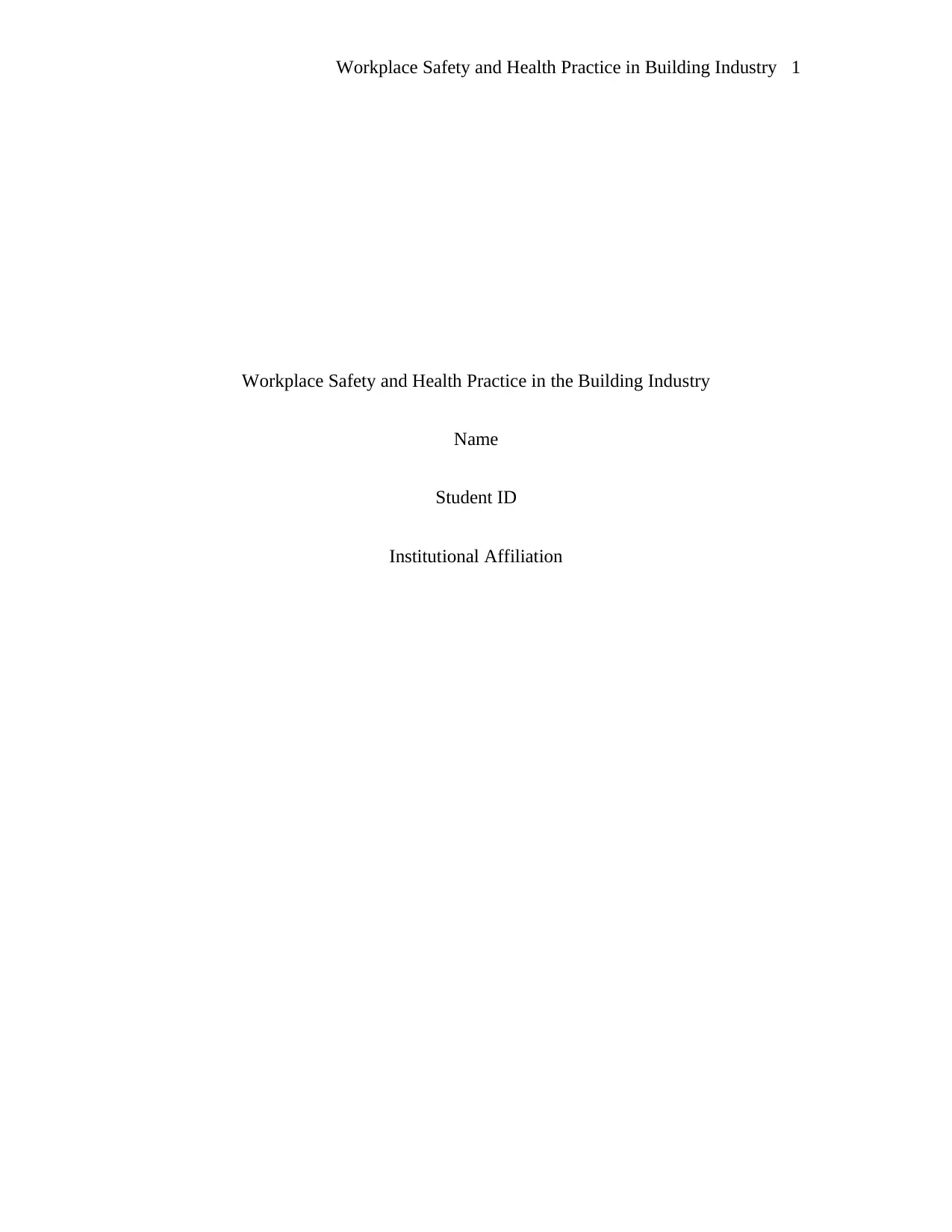
Workplace Safety and Health Practice in Building Industry 1
Workplace Safety and Health Practice in the Building Industry
Name
Student ID
Institutional Affiliation
Workplace Safety and Health Practice in the Building Industry
Name
Student ID
Institutional Affiliation
Secure Best Marks with AI Grader
Need help grading? Try our AI Grader for instant feedback on your assignments.
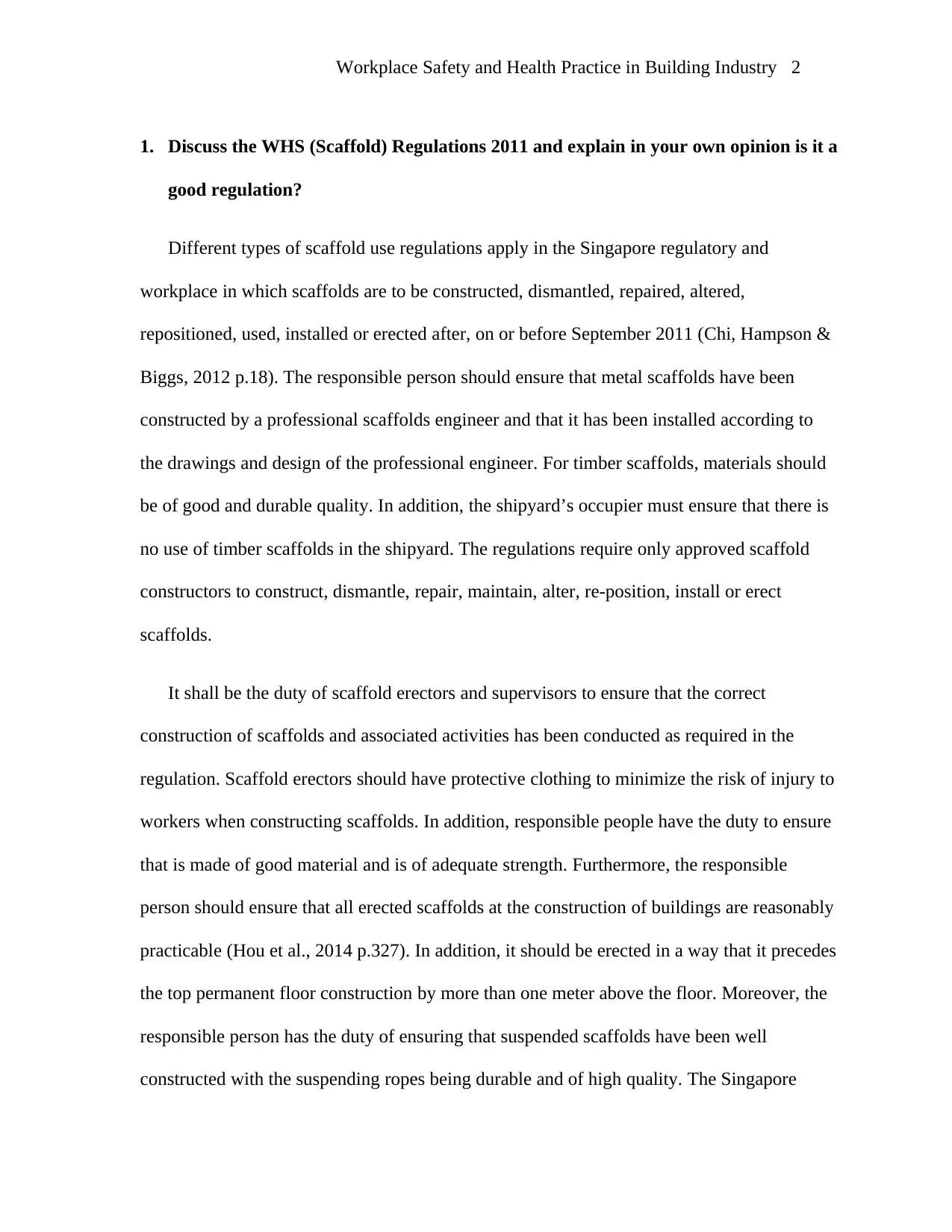
Workplace Safety and Health Practice in Building Industry 2
1. Discuss the WHS (Scaffold) Regulations 2011 and explain in your own opinion is it a
good regulation?
Different types of scaffold use regulations apply in the Singapore regulatory and
workplace in which scaffolds are to be constructed, dismantled, repaired, altered,
repositioned, used, installed or erected after, on or before September 2011 (Chi, Hampson &
Biggs, 2012 p.18). The responsible person should ensure that metal scaffolds have been
constructed by a professional scaffolds engineer and that it has been installed according to
the drawings and design of the professional engineer. For timber scaffolds, materials should
be of good and durable quality. In addition, the shipyard’s occupier must ensure that there is
no use of timber scaffolds in the shipyard. The regulations require only approved scaffold
constructors to construct, dismantle, repair, maintain, alter, re-position, install or erect
scaffolds.
It shall be the duty of scaffold erectors and supervisors to ensure that the correct
construction of scaffolds and associated activities has been conducted as required in the
regulation. Scaffold erectors should have protective clothing to minimize the risk of injury to
workers when constructing scaffolds. In addition, responsible people have the duty to ensure
that is made of good material and is of adequate strength. Furthermore, the responsible
person should ensure that all erected scaffolds at the construction of buildings are reasonably
practicable (Hou et al., 2014 p.327). In addition, it should be erected in a way that it precedes
the top permanent floor construction by more than one meter above the floor. Moreover, the
responsible person has the duty of ensuring that suspended scaffolds have been well
constructed with the suspending ropes being durable and of high quality. The Singapore
1. Discuss the WHS (Scaffold) Regulations 2011 and explain in your own opinion is it a
good regulation?
Different types of scaffold use regulations apply in the Singapore regulatory and
workplace in which scaffolds are to be constructed, dismantled, repaired, altered,
repositioned, used, installed or erected after, on or before September 2011 (Chi, Hampson &
Biggs, 2012 p.18). The responsible person should ensure that metal scaffolds have been
constructed by a professional scaffolds engineer and that it has been installed according to
the drawings and design of the professional engineer. For timber scaffolds, materials should
be of good and durable quality. In addition, the shipyard’s occupier must ensure that there is
no use of timber scaffolds in the shipyard. The regulations require only approved scaffold
constructors to construct, dismantle, repair, maintain, alter, re-position, install or erect
scaffolds.
It shall be the duty of scaffold erectors and supervisors to ensure that the correct
construction of scaffolds and associated activities has been conducted as required in the
regulation. Scaffold erectors should have protective clothing to minimize the risk of injury to
workers when constructing scaffolds. In addition, responsible people have the duty to ensure
that is made of good material and is of adequate strength. Furthermore, the responsible
person should ensure that all erected scaffolds at the construction of buildings are reasonably
practicable (Hou et al., 2014 p.327). In addition, it should be erected in a way that it precedes
the top permanent floor construction by more than one meter above the floor. Moreover, the
responsible person has the duty of ensuring that suspended scaffolds have been well
constructed with the suspending ropes being durable and of high quality. The Singapore
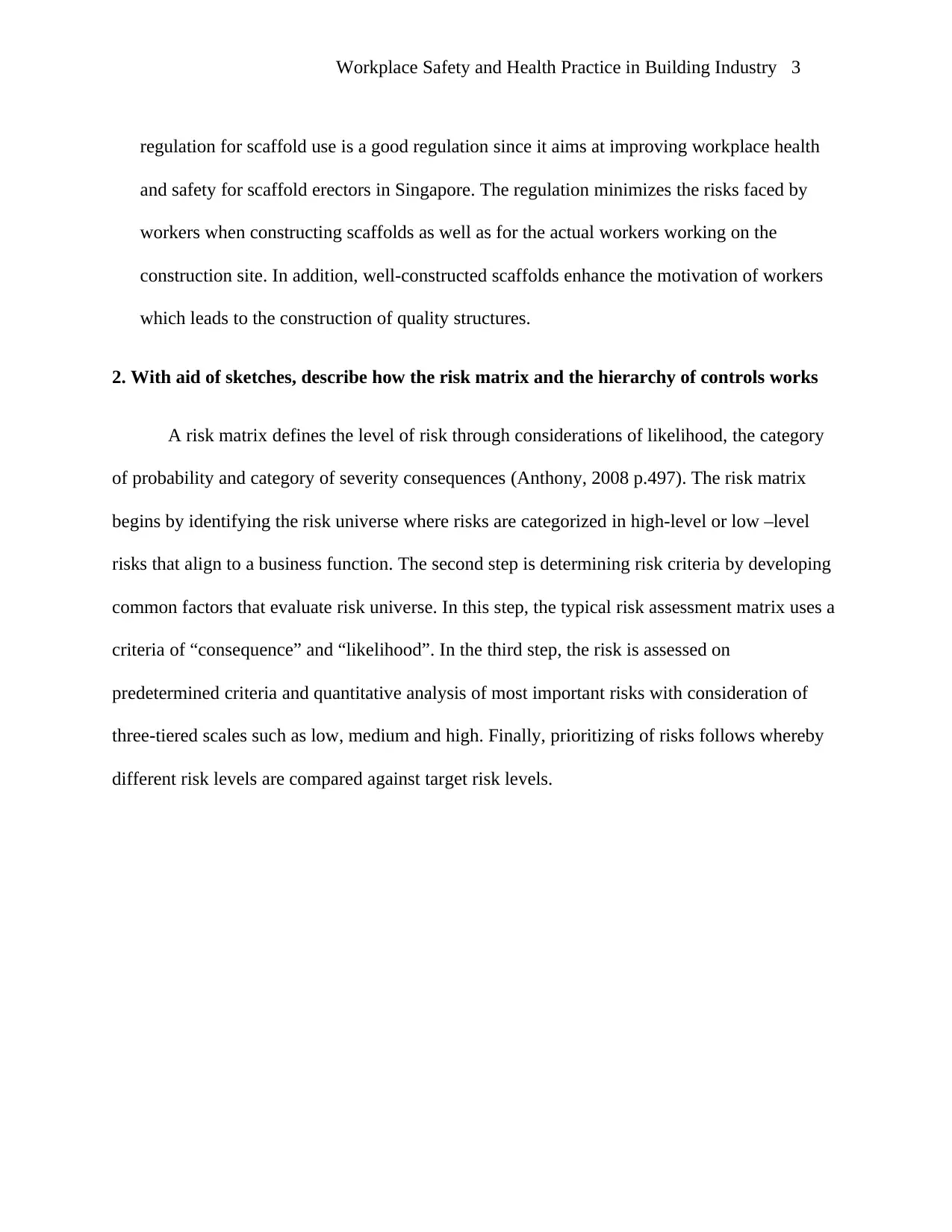
Workplace Safety and Health Practice in Building Industry 3
regulation for scaffold use is a good regulation since it aims at improving workplace health
and safety for scaffold erectors in Singapore. The regulation minimizes the risks faced by
workers when constructing scaffolds as well as for the actual workers working on the
construction site. In addition, well-constructed scaffolds enhance the motivation of workers
which leads to the construction of quality structures.
2. With aid of sketches, describe how the risk matrix and the hierarchy of controls works
A risk matrix defines the level of risk through considerations of likelihood, the category
of probability and category of severity consequences (Anthony, 2008 p.497). The risk matrix
begins by identifying the risk universe where risks are categorized in high-level or low –level
risks that align to a business function. The second step is determining risk criteria by developing
common factors that evaluate risk universe. In this step, the typical risk assessment matrix uses a
criteria of “consequence” and “likelihood”. In the third step, the risk is assessed on
predetermined criteria and quantitative analysis of most important risks with consideration of
three-tiered scales such as low, medium and high. Finally, prioritizing of risks follows whereby
different risk levels are compared against target risk levels.
regulation for scaffold use is a good regulation since it aims at improving workplace health
and safety for scaffold erectors in Singapore. The regulation minimizes the risks faced by
workers when constructing scaffolds as well as for the actual workers working on the
construction site. In addition, well-constructed scaffolds enhance the motivation of workers
which leads to the construction of quality structures.
2. With aid of sketches, describe how the risk matrix and the hierarchy of controls works
A risk matrix defines the level of risk through considerations of likelihood, the category
of probability and category of severity consequences (Anthony, 2008 p.497). The risk matrix
begins by identifying the risk universe where risks are categorized in high-level or low –level
risks that align to a business function. The second step is determining risk criteria by developing
common factors that evaluate risk universe. In this step, the typical risk assessment matrix uses a
criteria of “consequence” and “likelihood”. In the third step, the risk is assessed on
predetermined criteria and quantitative analysis of most important risks with consideration of
three-tiered scales such as low, medium and high. Finally, prioritizing of risks follows whereby
different risk levels are compared against target risk levels.

Workplace Safety and Health Practice in Building Industry 4
Risk matrix
Source (Aven, 2008 p.790).
The hierarchy of controls begins by eliminating or substituting the risks whereby hazards
are removed physically or replaced with other hazards that do not produce hazards. Engineering
controls follow whereby mechanical guards are implemented to prevent risks. The mechanical
guards are designed to act automatically to prevent risks. Awareness process and information use
follow whereby awareness devices are used to identify risks. The awareness devices include
warning lights, buzzers and bells. The “information use” includes manuals, warning signs and
labels like “slippery floor” and “mind your head”. The final hierarchy of control involves
administration control and provision of personal protective equipment. Administrative controls
include standards operating procedures (SOP’s), training, safe working procedures and
supervision. Personal protective equipment include equipment like work boots and safety
glasses.
Risk matrix
Source (Aven, 2008 p.790).
The hierarchy of controls begins by eliminating or substituting the risks whereby hazards
are removed physically or replaced with other hazards that do not produce hazards. Engineering
controls follow whereby mechanical guards are implemented to prevent risks. The mechanical
guards are designed to act automatically to prevent risks. Awareness process and information use
follow whereby awareness devices are used to identify risks. The awareness devices include
warning lights, buzzers and bells. The “information use” includes manuals, warning signs and
labels like “slippery floor” and “mind your head”. The final hierarchy of control involves
administration control and provision of personal protective equipment. Administrative controls
include standards operating procedures (SOP’s), training, safe working procedures and
supervision. Personal protective equipment include equipment like work boots and safety
glasses.
Secure Best Marks with AI Grader
Need help grading? Try our AI Grader for instant feedback on your assignments.
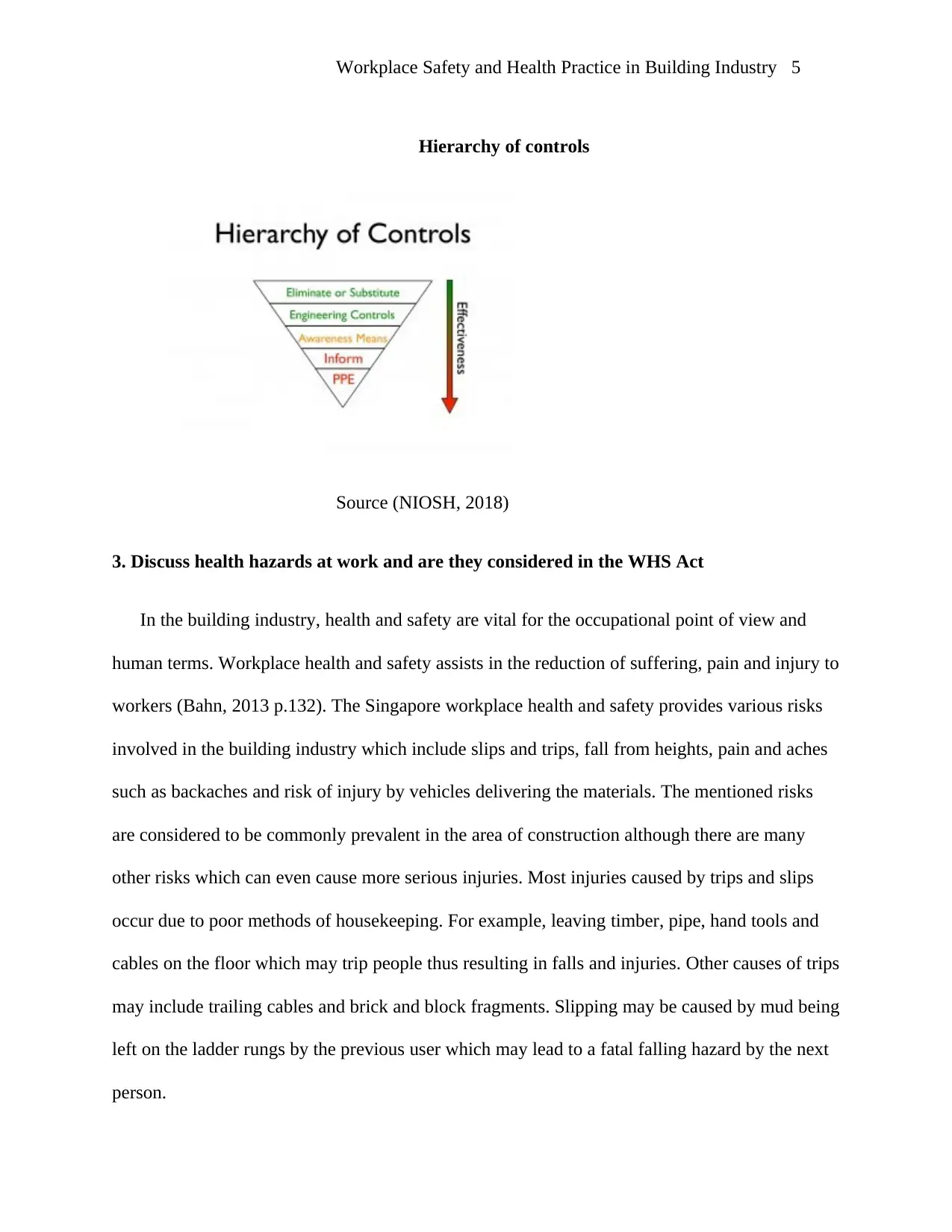
Workplace Safety and Health Practice in Building Industry 5
Hierarchy of controls
Source (NIOSH, 2018)
3. Discuss health hazards at work and are they considered in the WHS Act
In the building industry, health and safety are vital for the occupational point of view and
human terms. Workplace health and safety assists in the reduction of suffering, pain and injury to
workers (Bahn, 2013 p.132). The Singapore workplace health and safety provides various risks
involved in the building industry which include slips and trips, fall from heights, pain and aches
such as backaches and risk of injury by vehicles delivering the materials. The mentioned risks
are considered to be commonly prevalent in the area of construction although there are many
other risks which can even cause more serious injuries. Most injuries caused by trips and slips
occur due to poor methods of housekeeping. For example, leaving timber, pipe, hand tools and
cables on the floor which may trip people thus resulting in falls and injuries. Other causes of trips
may include trailing cables and brick and block fragments. Slipping may be caused by mud being
left on the ladder rungs by the previous user which may lead to a fatal falling hazard by the next
person.
Hierarchy of controls
Source (NIOSH, 2018)
3. Discuss health hazards at work and are they considered in the WHS Act
In the building industry, health and safety are vital for the occupational point of view and
human terms. Workplace health and safety assists in the reduction of suffering, pain and injury to
workers (Bahn, 2013 p.132). The Singapore workplace health and safety provides various risks
involved in the building industry which include slips and trips, fall from heights, pain and aches
such as backaches and risk of injury by vehicles delivering the materials. The mentioned risks
are considered to be commonly prevalent in the area of construction although there are many
other risks which can even cause more serious injuries. Most injuries caused by trips and slips
occur due to poor methods of housekeeping. For example, leaving timber, pipe, hand tools and
cables on the floor which may trip people thus resulting in falls and injuries. Other causes of trips
may include trailing cables and brick and block fragments. Slipping may be caused by mud being
left on the ladder rungs by the previous user which may lead to a fatal falling hazard by the next
person.
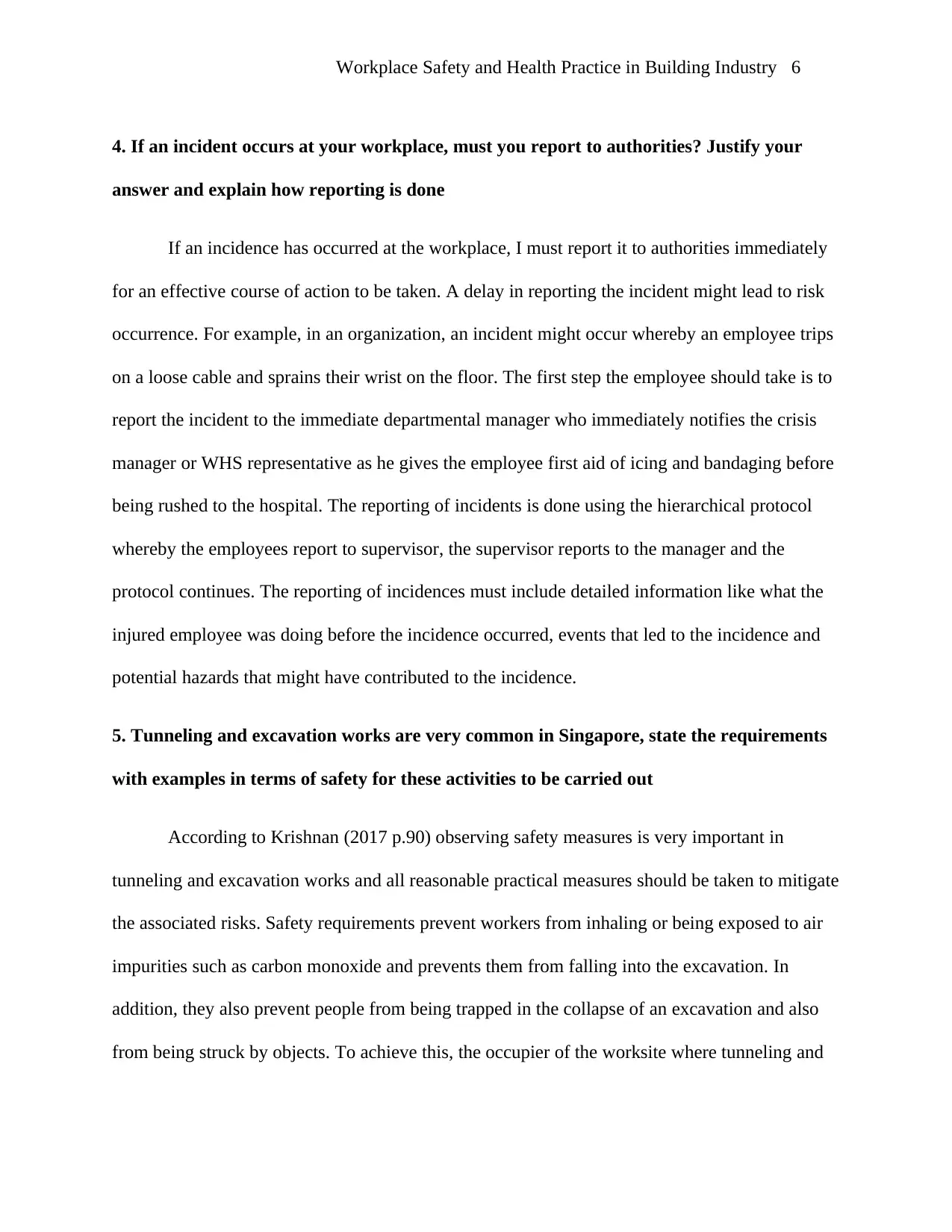
Workplace Safety and Health Practice in Building Industry 6
4. If an incident occurs at your workplace, must you report to authorities? Justify your
answer and explain how reporting is done
If an incidence has occurred at the workplace, I must report it to authorities immediately
for an effective course of action to be taken. A delay in reporting the incident might lead to risk
occurrence. For example, in an organization, an incident might occur whereby an employee trips
on a loose cable and sprains their wrist on the floor. The first step the employee should take is to
report the incident to the immediate departmental manager who immediately notifies the crisis
manager or WHS representative as he gives the employee first aid of icing and bandaging before
being rushed to the hospital. The reporting of incidents is done using the hierarchical protocol
whereby the employees report to supervisor, the supervisor reports to the manager and the
protocol continues. The reporting of incidences must include detailed information like what the
injured employee was doing before the incidence occurred, events that led to the incidence and
potential hazards that might have contributed to the incidence.
5. Tunneling and excavation works are very common in Singapore, state the requirements
with examples in terms of safety for these activities to be carried out
According to Krishnan (2017 p.90) observing safety measures is very important in
tunneling and excavation works and all reasonable practical measures should be taken to mitigate
the associated risks. Safety requirements prevent workers from inhaling or being exposed to air
impurities such as carbon monoxide and prevents them from falling into the excavation. In
addition, they also prevent people from being trapped in the collapse of an excavation and also
from being struck by objects. To achieve this, the occupier of the worksite where tunneling and
4. If an incident occurs at your workplace, must you report to authorities? Justify your
answer and explain how reporting is done
If an incidence has occurred at the workplace, I must report it to authorities immediately
for an effective course of action to be taken. A delay in reporting the incident might lead to risk
occurrence. For example, in an organization, an incident might occur whereby an employee trips
on a loose cable and sprains their wrist on the floor. The first step the employee should take is to
report the incident to the immediate departmental manager who immediately notifies the crisis
manager or WHS representative as he gives the employee first aid of icing and bandaging before
being rushed to the hospital. The reporting of incidents is done using the hierarchical protocol
whereby the employees report to supervisor, the supervisor reports to the manager and the
protocol continues. The reporting of incidences must include detailed information like what the
injured employee was doing before the incidence occurred, events that led to the incidence and
potential hazards that might have contributed to the incidence.
5. Tunneling and excavation works are very common in Singapore, state the requirements
with examples in terms of safety for these activities to be carried out
According to Krishnan (2017 p.90) observing safety measures is very important in
tunneling and excavation works and all reasonable practical measures should be taken to mitigate
the associated risks. Safety requirements prevent workers from inhaling or being exposed to air
impurities such as carbon monoxide and prevents them from falling into the excavation. In
addition, they also prevent people from being trapped in the collapse of an excavation and also
from being struck by objects. To achieve this, the occupier of the worksite where tunneling and
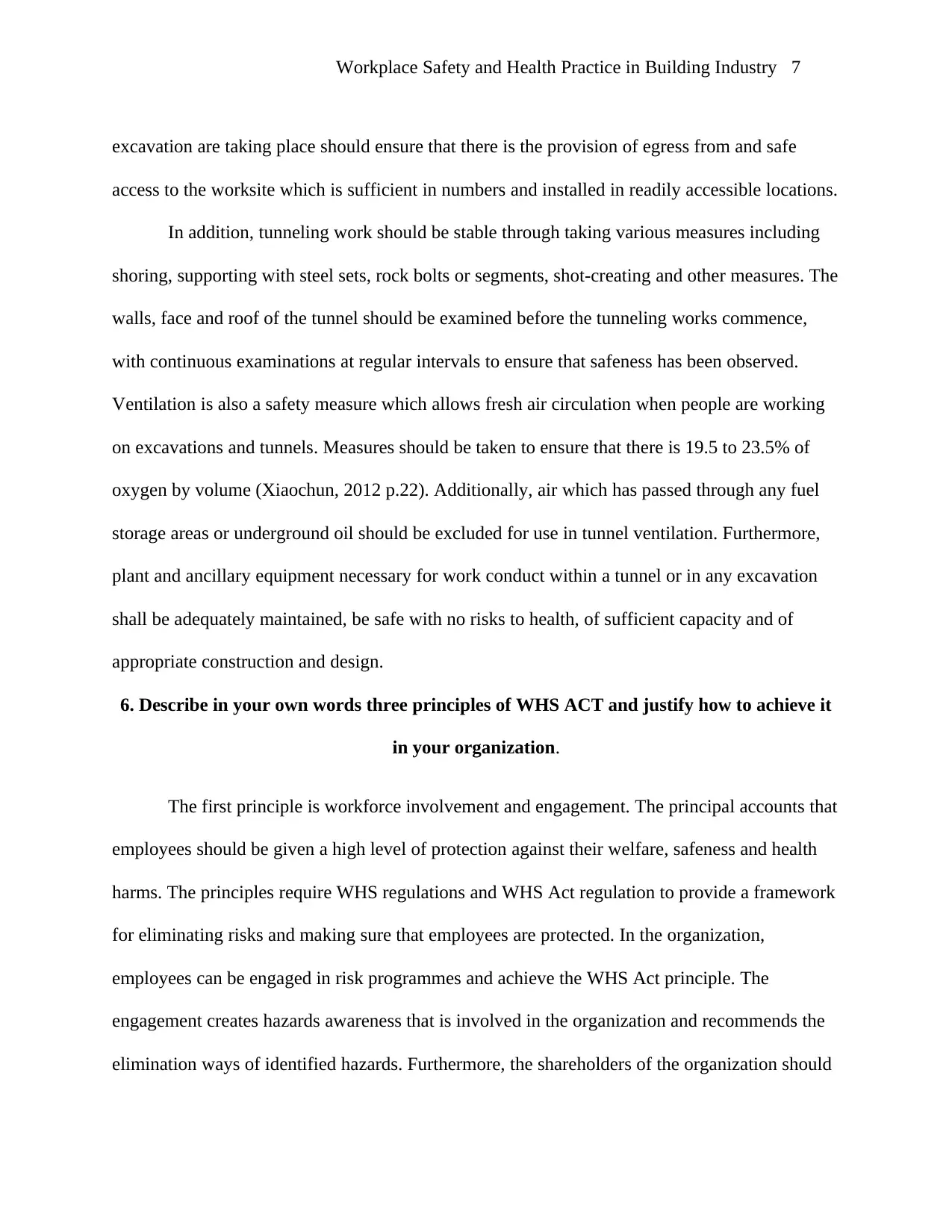
Workplace Safety and Health Practice in Building Industry 7
excavation are taking place should ensure that there is the provision of egress from and safe
access to the worksite which is sufficient in numbers and installed in readily accessible locations.
In addition, tunneling work should be stable through taking various measures including
shoring, supporting with steel sets, rock bolts or segments, shot-creating and other measures. The
walls, face and roof of the tunnel should be examined before the tunneling works commence,
with continuous examinations at regular intervals to ensure that safeness has been observed.
Ventilation is also a safety measure which allows fresh air circulation when people are working
on excavations and tunnels. Measures should be taken to ensure that there is 19.5 to 23.5% of
oxygen by volume (Xiaochun, 2012 p.22). Additionally, air which has passed through any fuel
storage areas or underground oil should be excluded for use in tunnel ventilation. Furthermore,
plant and ancillary equipment necessary for work conduct within a tunnel or in any excavation
shall be adequately maintained, be safe with no risks to health, of sufficient capacity and of
appropriate construction and design.
6. Describe in your own words three principles of WHS ACT and justify how to achieve it
in your organization.
The first principle is workforce involvement and engagement. The principal accounts that
employees should be given a high level of protection against their welfare, safeness and health
harms. The principles require WHS regulations and WHS Act regulation to provide a framework
for eliminating risks and making sure that employees are protected. In the organization,
employees can be engaged in risk programmes and achieve the WHS Act principle. The
engagement creates hazards awareness that is involved in the organization and recommends the
elimination ways of identified hazards. Furthermore, the shareholders of the organization should
excavation are taking place should ensure that there is the provision of egress from and safe
access to the worksite which is sufficient in numbers and installed in readily accessible locations.
In addition, tunneling work should be stable through taking various measures including
shoring, supporting with steel sets, rock bolts or segments, shot-creating and other measures. The
walls, face and roof of the tunnel should be examined before the tunneling works commence,
with continuous examinations at regular intervals to ensure that safeness has been observed.
Ventilation is also a safety measure which allows fresh air circulation when people are working
on excavations and tunnels. Measures should be taken to ensure that there is 19.5 to 23.5% of
oxygen by volume (Xiaochun, 2012 p.22). Additionally, air which has passed through any fuel
storage areas or underground oil should be excluded for use in tunnel ventilation. Furthermore,
plant and ancillary equipment necessary for work conduct within a tunnel or in any excavation
shall be adequately maintained, be safe with no risks to health, of sufficient capacity and of
appropriate construction and design.
6. Describe in your own words three principles of WHS ACT and justify how to achieve it
in your organization.
The first principle is workforce involvement and engagement. The principal accounts that
employees should be given a high level of protection against their welfare, safeness and health
harms. The principles require WHS regulations and WHS Act regulation to provide a framework
for eliminating risks and making sure that employees are protected. In the organization,
employees can be engaged in risk programmes and achieve the WHS Act principle. The
engagement creates hazards awareness that is involved in the organization and recommends the
elimination ways of identified hazards. Furthermore, the shareholders of the organization should
Paraphrase This Document
Need a fresh take? Get an instant paraphrase of this document with our AI Paraphraser
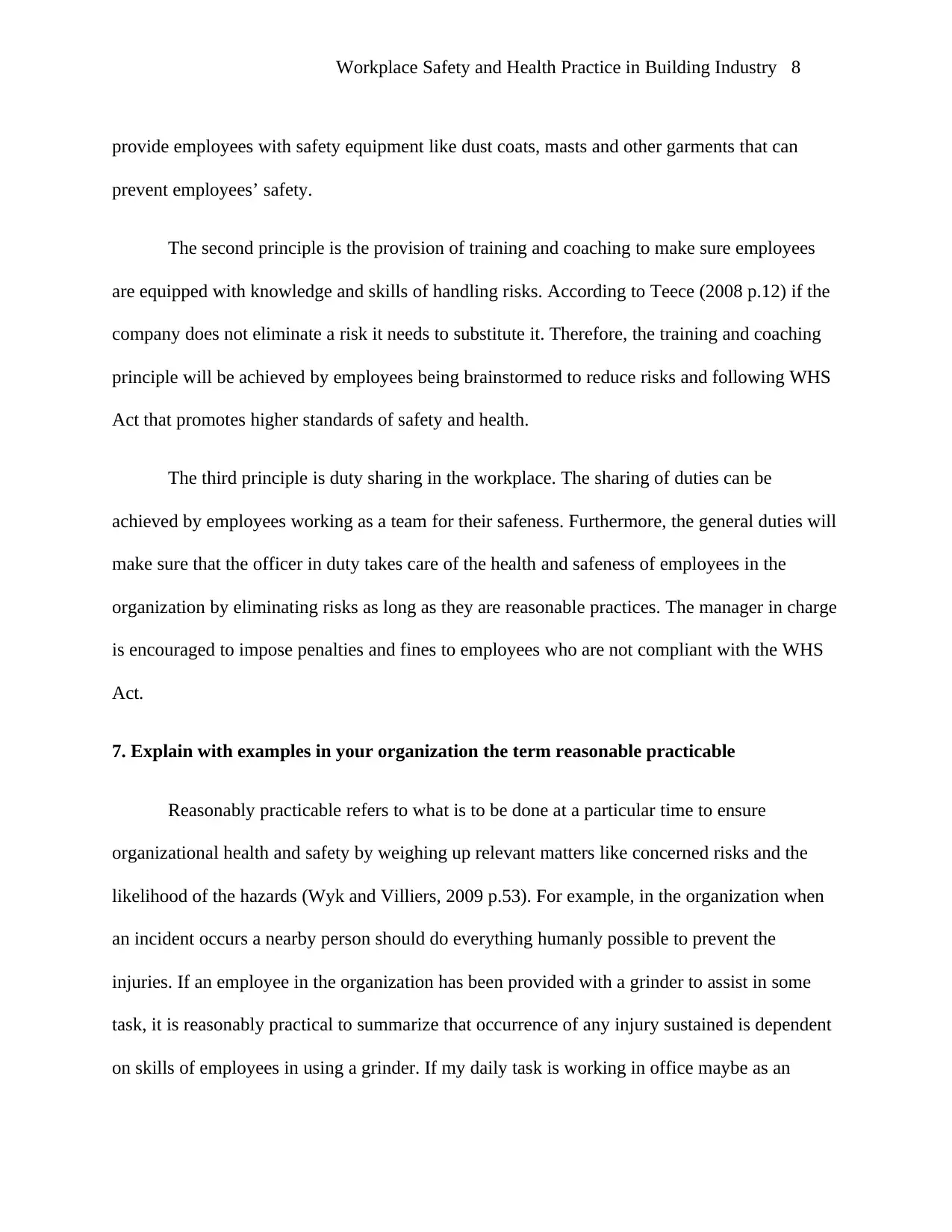
Workplace Safety and Health Practice in Building Industry 8
provide employees with safety equipment like dust coats, masts and other garments that can
prevent employees’ safety.
The second principle is the provision of training and coaching to make sure employees
are equipped with knowledge and skills of handling risks. According to Teece (2008 p.12) if the
company does not eliminate a risk it needs to substitute it. Therefore, the training and coaching
principle will be achieved by employees being brainstormed to reduce risks and following WHS
Act that promotes higher standards of safety and health.
The third principle is duty sharing in the workplace. The sharing of duties can be
achieved by employees working as a team for their safeness. Furthermore, the general duties will
make sure that the officer in duty takes care of the health and safeness of employees in the
organization by eliminating risks as long as they are reasonable practices. The manager in charge
is encouraged to impose penalties and fines to employees who are not compliant with the WHS
Act.
7. Explain with examples in your organization the term reasonable practicable
Reasonably practicable refers to what is to be done at a particular time to ensure
organizational health and safety by weighing up relevant matters like concerned risks and the
likelihood of the hazards (Wyk and Villiers, 2009 p.53). For example, in the organization when
an incident occurs a nearby person should do everything humanly possible to prevent the
injuries. If an employee in the organization has been provided with a grinder to assist in some
task, it is reasonably practical to summarize that occurrence of any injury sustained is dependent
on skills of employees in using a grinder. If my daily task is working in office maybe as an
provide employees with safety equipment like dust coats, masts and other garments that can
prevent employees’ safety.
The second principle is the provision of training and coaching to make sure employees
are equipped with knowledge and skills of handling risks. According to Teece (2008 p.12) if the
company does not eliminate a risk it needs to substitute it. Therefore, the training and coaching
principle will be achieved by employees being brainstormed to reduce risks and following WHS
Act that promotes higher standards of safety and health.
The third principle is duty sharing in the workplace. The sharing of duties can be
achieved by employees working as a team for their safeness. Furthermore, the general duties will
make sure that the officer in duty takes care of the health and safeness of employees in the
organization by eliminating risks as long as they are reasonable practices. The manager in charge
is encouraged to impose penalties and fines to employees who are not compliant with the WHS
Act.
7. Explain with examples in your organization the term reasonable practicable
Reasonably practicable refers to what is to be done at a particular time to ensure
organizational health and safety by weighing up relevant matters like concerned risks and the
likelihood of the hazards (Wyk and Villiers, 2009 p.53). For example, in the organization when
an incident occurs a nearby person should do everything humanly possible to prevent the
injuries. If an employee in the organization has been provided with a grinder to assist in some
task, it is reasonably practical to summarize that occurrence of any injury sustained is dependent
on skills of employees in using a grinder. If my daily task is working in office maybe as an
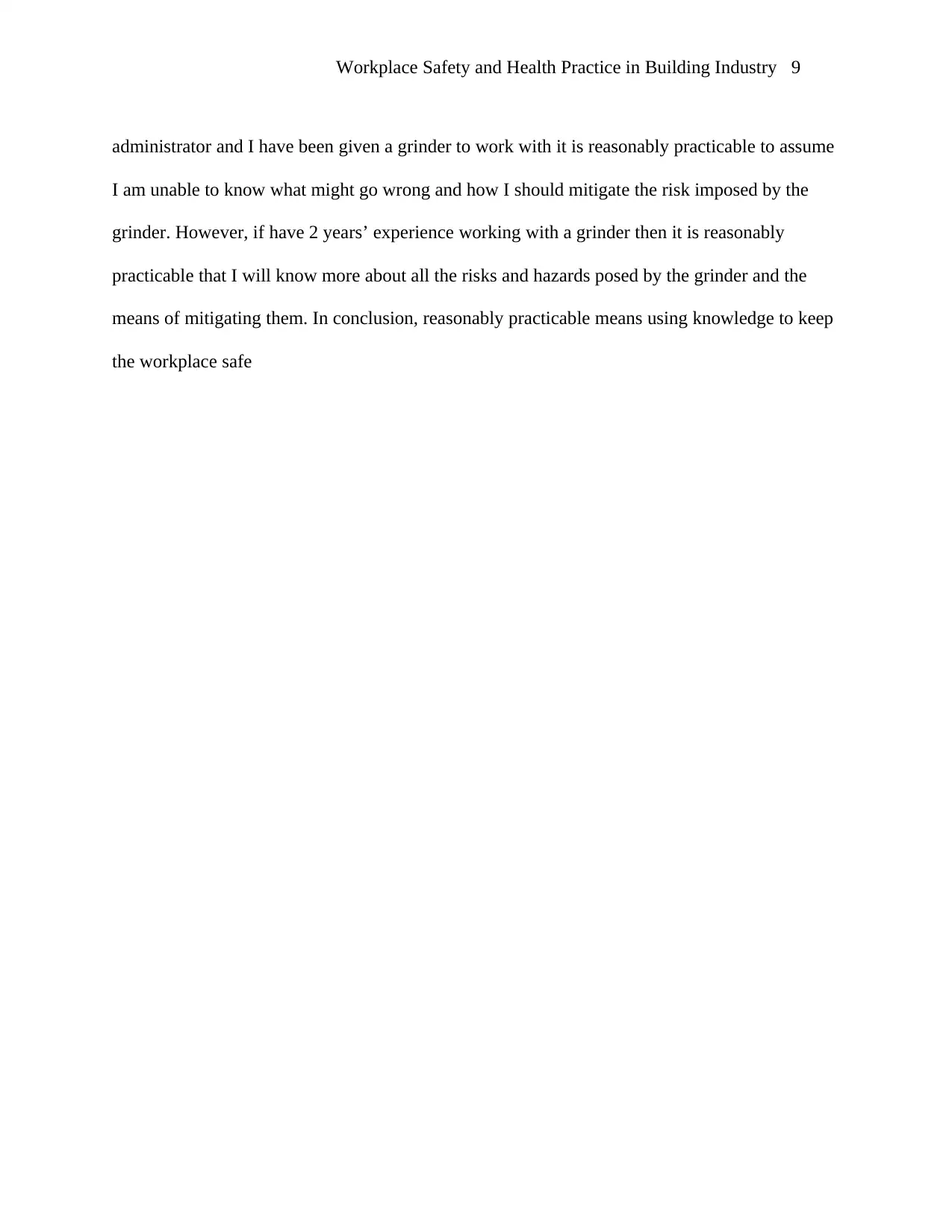
Workplace Safety and Health Practice in Building Industry 9
administrator and I have been given a grinder to work with it is reasonably practicable to assume
I am unable to know what might go wrong and how I should mitigate the risk imposed by the
grinder. However, if have 2 years’ experience working with a grinder then it is reasonably
practicable that I will know more about all the risks and hazards posed by the grinder and the
means of mitigating them. In conclusion, reasonably practicable means using knowledge to keep
the workplace safe
administrator and I have been given a grinder to work with it is reasonably practicable to assume
I am unable to know what might go wrong and how I should mitigate the risk imposed by the
grinder. However, if have 2 years’ experience working with a grinder then it is reasonably
practicable that I will know more about all the risks and hazards posed by the grinder and the
means of mitigating them. In conclusion, reasonably practicable means using knowledge to keep
the workplace safe
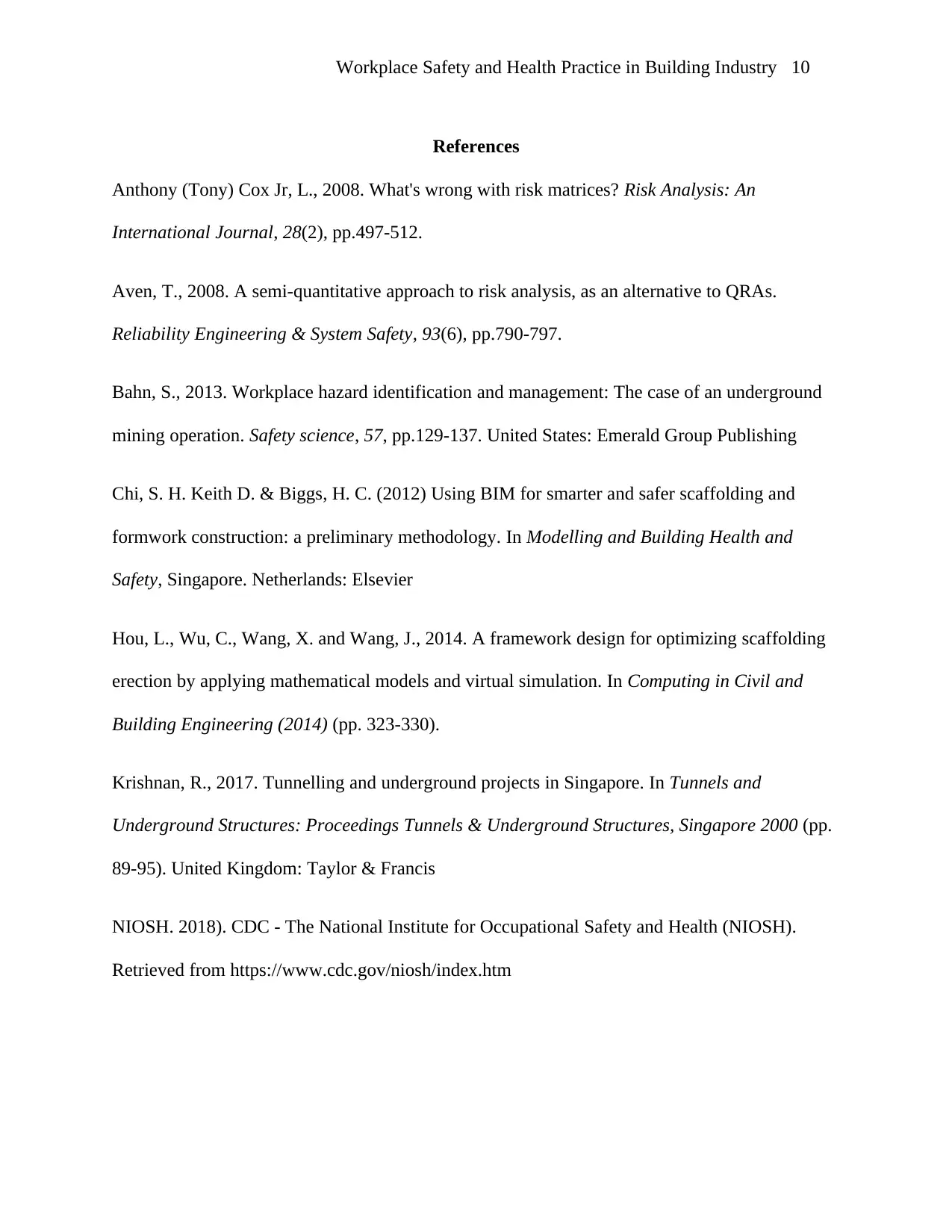
Workplace Safety and Health Practice in Building Industry 10
References
Anthony (Tony) Cox Jr, L., 2008. What's wrong with risk matrices? Risk Analysis: An
International Journal, 28(2), pp.497-512.
Aven, T., 2008. A semi-quantitative approach to risk analysis, as an alternative to QRAs.
Reliability Engineering & System Safety, 93(6), pp.790-797.
Bahn, S., 2013. Workplace hazard identification and management: The case of an underground
mining operation. Safety science, 57, pp.129-137. United States: Emerald Group Publishing
Chi, S. H. Keith D. & Biggs, H. C. (2012) Using BIM for smarter and safer scaffolding and
formwork construction: a preliminary methodology. In Modelling and Building Health and
Safety, Singapore. Netherlands: Elsevier
Hou, L., Wu, C., Wang, X. and Wang, J., 2014. A framework design for optimizing scaffolding
erection by applying mathematical models and virtual simulation. In Computing in Civil and
Building Engineering (2014) (pp. 323-330).
Krishnan, R., 2017. Tunnelling and underground projects in Singapore. In Tunnels and
Underground Structures: Proceedings Tunnels & Underground Structures, Singapore 2000 (pp.
89-95). United Kingdom: Taylor & Francis
NIOSH. 2018). CDC - The National Institute for Occupational Safety and Health (NIOSH).
Retrieved from https://www.cdc.gov/niosh/index.htm
References
Anthony (Tony) Cox Jr, L., 2008. What's wrong with risk matrices? Risk Analysis: An
International Journal, 28(2), pp.497-512.
Aven, T., 2008. A semi-quantitative approach to risk analysis, as an alternative to QRAs.
Reliability Engineering & System Safety, 93(6), pp.790-797.
Bahn, S., 2013. Workplace hazard identification and management: The case of an underground
mining operation. Safety science, 57, pp.129-137. United States: Emerald Group Publishing
Chi, S. H. Keith D. & Biggs, H. C. (2012) Using BIM for smarter and safer scaffolding and
formwork construction: a preliminary methodology. In Modelling and Building Health and
Safety, Singapore. Netherlands: Elsevier
Hou, L., Wu, C., Wang, X. and Wang, J., 2014. A framework design for optimizing scaffolding
erection by applying mathematical models and virtual simulation. In Computing in Civil and
Building Engineering (2014) (pp. 323-330).
Krishnan, R., 2017. Tunnelling and underground projects in Singapore. In Tunnels and
Underground Structures: Proceedings Tunnels & Underground Structures, Singapore 2000 (pp.
89-95). United Kingdom: Taylor & Francis
NIOSH. 2018). CDC - The National Institute for Occupational Safety and Health (NIOSH).
Retrieved from https://www.cdc.gov/niosh/index.htm
Secure Best Marks with AI Grader
Need help grading? Try our AI Grader for instant feedback on your assignments.
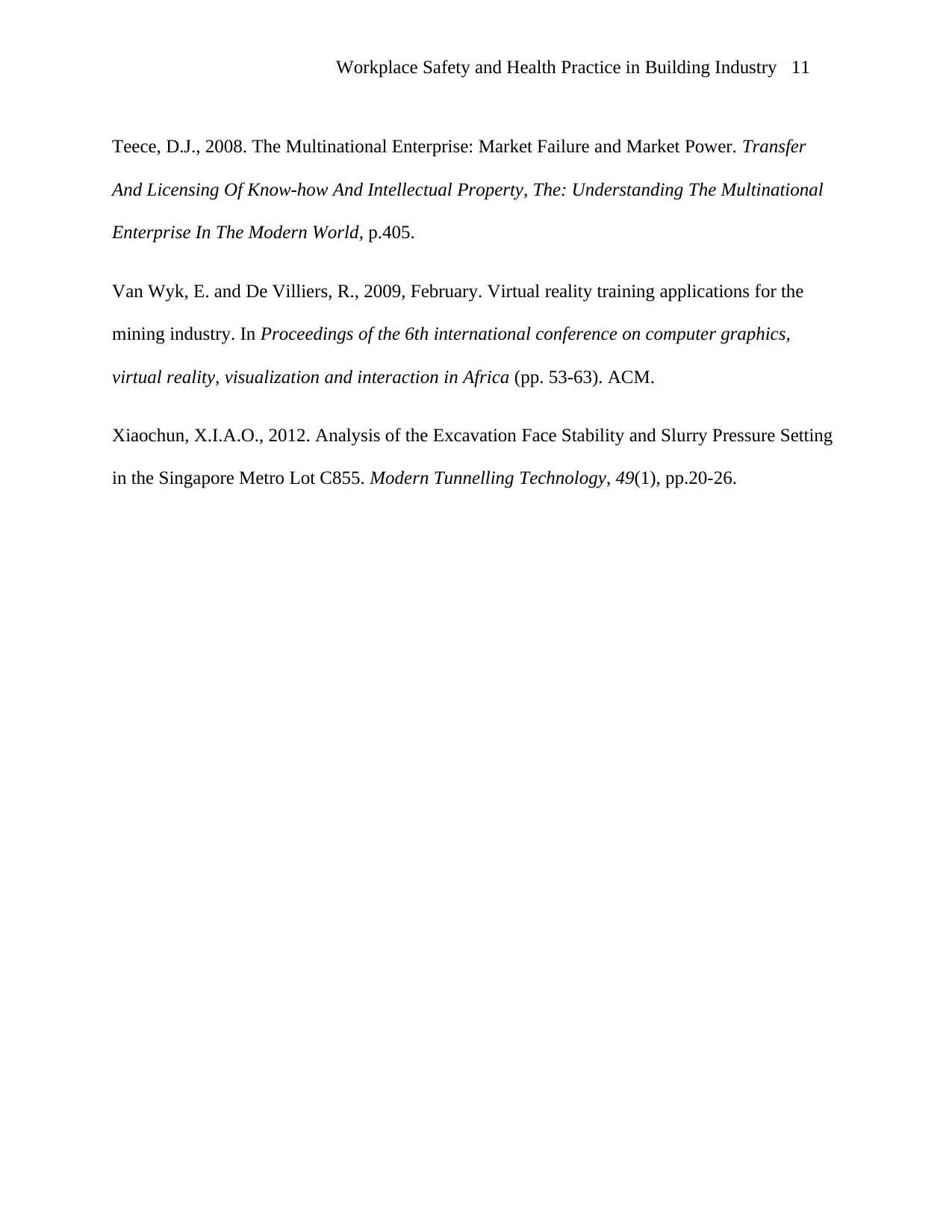
Workplace Safety and Health Practice in Building Industry 11
Teece, D.J., 2008. The Multinational Enterprise: Market Failure and Market Power. Transfer
And Licensing Of Know-how And Intellectual Property, The: Understanding The Multinational
Enterprise In The Modern World, p.405.
Van Wyk, E. and De Villiers, R., 2009, February. Virtual reality training applications for the
mining industry. In Proceedings of the 6th international conference on computer graphics,
virtual reality, visualization and interaction in Africa (pp. 53-63). ACM.
Xiaochun, X.I.A.O., 2012. Analysis of the Excavation Face Stability and Slurry Pressure Setting
in the Singapore Metro Lot C855. Modern Tunnelling Technology, 49(1), pp.20-26.
Teece, D.J., 2008. The Multinational Enterprise: Market Failure and Market Power. Transfer
And Licensing Of Know-how And Intellectual Property, The: Understanding The Multinational
Enterprise In The Modern World, p.405.
Van Wyk, E. and De Villiers, R., 2009, February. Virtual reality training applications for the
mining industry. In Proceedings of the 6th international conference on computer graphics,
virtual reality, visualization and interaction in Africa (pp. 53-63). ACM.
Xiaochun, X.I.A.O., 2012. Analysis of the Excavation Face Stability and Slurry Pressure Setting
in the Singapore Metro Lot C855. Modern Tunnelling Technology, 49(1), pp.20-26.
1 out of 11
Related Documents
Your All-in-One AI-Powered Toolkit for Academic Success.
+13062052269
info@desklib.com
Available 24*7 on WhatsApp / Email
![[object Object]](/_next/static/media/star-bottom.7253800d.svg)
Unlock your academic potential
© 2024 | Zucol Services PVT LTD | All rights reserved.





